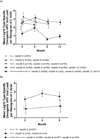Viral load and short-term natural history of type-specific oncogenic human papillomavirus infections in a high-risk cohort of midadult women
- PMID: 24136492
- PMCID: PMC3947429
- DOI: 10.1002/ijc.28509
Viral load and short-term natural history of type-specific oncogenic human papillomavirus infections in a high-risk cohort of midadult women
Abstract
Oncogenic human papillomavirus (HPV) viral load may inform the origin of newly detected infections and characterize oncogenic HPV natural history in midadult women. From 2007 to 2011, we enrolled 521 25-65-year-old-female online daters and followed them triannually with mailed health and sexual behavior questionnaires and kits for self-sampling for PCR-based HPV DNA testing. Samples from oncogenic HPV positive women were selected for type-specific DNA load testing by real-time PCR with adjustment for cellularity. Linear or logistic regression models were used to evaluate relationships between viral levels, health and sexual behavior, and longitudinal oncogenic HPV detection. Type-specific viral levels were borderline significantly higher in oncogenic HPV infections that were prevalent versus newly detected (p = 0.092), but levels in newly detected infections were higher than in infections redetected after intercurrent negativity (p < 0.001). Recent sex partners were not significantly associated with viral levels. Compared with prevalent infections detected intermittently, the likelihood of persistent (OR = 4.31, 95% CI: 2.20-8.45) or single-time (OR = 1.32, 95% CI: 1.03-1.71) detection increased per 1-unit increase in baseline log10 viral load. Viral load differences between redetected and newly detected infections suggest a portion of new detections were due to new acquisition, although report of recent new sex partners (a potential marker of new infection) was not predictive of viral load; oncogenic HPV infections in midadult women with new partners likely represent a mix of new acquisition and reactivation or intermittent detection of previous infection. Intermittent detection was characterized by low viral levels, suggesting that intermittent detection of persisting oncogenic HPV infection may be of limited clinical significance.
Keywords: epidemiology; human papillomavirus; persistence; viral load; women.
© 2013 UICC.
Figures


Similar articles
-
Short-term natural history of high-risk human papillomavirus infection in mid-adult women sampled monthly.Int J Cancer. 2015 Nov 15;137(10):2432-42. doi: 10.1002/ijc.29602. Epub 2015 May 29. Int J Cancer. 2015. PMID: 25976733 Free PMC article.
-
Prevalence and risk factors for oncogenic human papillomavirus infections in high-risk mid-adult women.Sex Transm Dis. 2012 Nov;39(11):848-56. doi: 10.1097/OLQ.0b013e3182641f1c. Sex Transm Dis. 2012. PMID: 23064533 Free PMC article.
-
Oncogenic Human Papillomavirus Infections in 18- to 24-Year-Old Female Online Daters.Sex Transm Dis. 2015 Sep;42(9):492-7. doi: 10.1097/OLQ.0000000000000331. Sex Transm Dis. 2015. PMID: 26267875 Free PMC article.
-
Prevalence and viral load of oncogenic human papillomavirus types associated with cervical carcinoma in a population of North Italy.J Med Virol. 2009 Feb;81(2):278-87. doi: 10.1002/jmv.21395. J Med Virol. 2009. PMID: 19107971
-
Increased human papillomavirus viral load is correlated to higher severity of cervical disease and poorer clinical outcome: A systematic review.J Med Virol. 2024 Jun;96(6):e29741. doi: 10.1002/jmv.29741. J Med Virol. 2024. PMID: 38922964
Cited by
-
Analysis of longitudinal multivariate outcome data from couples cohort studies: application to HPV transmission dynamics.J Am Stat Assoc. 2015 Jun 1;110(510):472-485. doi: 10.1080/01621459.2014.991394. J Am Stat Assoc. 2015. PMID: 26195849 Free PMC article.
-
Short-term natural history of high-risk human papillomavirus infection in mid-adult women sampled monthly.Int J Cancer. 2015 Nov 15;137(10):2432-42. doi: 10.1002/ijc.29602. Epub 2015 May 29. Int J Cancer. 2015. PMID: 25976733 Free PMC article.
-
Quantitative Oral HPV16 and HPV18 Detection in Persons Attending Dental Clinics.Sex Transm Dis. 2020 Feb;47(2):100-104. doi: 10.1097/OLQ.0000000000001097. Sex Transm Dis. 2020. PMID: 31804297 Free PMC article.
-
Human papillomavirus 16 non-European variants are preferentially associated with high-grade cervical lesions.PLoS One. 2014 Jul 1;9(7):e100746. doi: 10.1371/journal.pone.0100746. eCollection 2014. PLoS One. 2014. PMID: 24983739 Free PMC article. Clinical Trial.
-
Persistence of type-specific human papillomavirus infection among Daqing City women in China with normal cytology: a pilot prospective study.Oncotarget. 2017 Aug 11;8(46):81455-81461. doi: 10.18632/oncotarget.20188. eCollection 2017 Oct 6. Oncotarget. 2017. PMID: 29113404 Free PMC article.
References
-
- Grant LA, Dunne EF, Chesson H, Markowitz LE. Considerations for human papillomavirus (HPV) vaccination of mid-adult women in the United States. Vaccine. 2011;29:2365–2370. - PubMed
-
- Burchell AN, Winer RL, de Sanjose S, Franco EL. Chapter 6: Epidemiology and transmission dynamics of genital HPV infection. Vaccine. 2006;24(Suppl 3):S52–S61. - PubMed
-
- Moscicki AB, Schiffman M, Kjaer S, Villa LL. Chapter 5: Updating the natural history of HPV and anogenital cancer. Vaccine. 2006;24(Suppl 3):S42–S51. - PubMed
Publication types
MeSH terms
Substances
Grants and funding
LinkOut - more resources
Full Text Sources
Other Literature Sources

